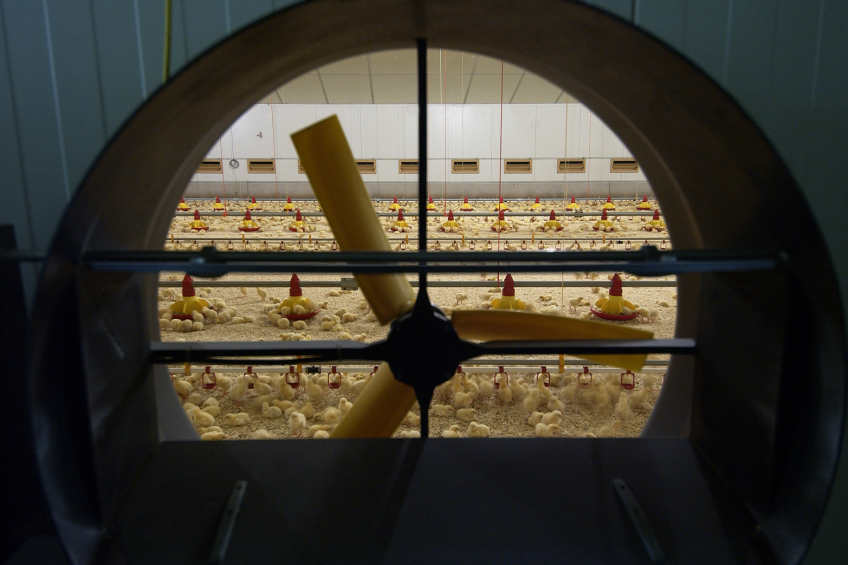Target reduction in antibiotics: 70 percent

The usage of antibiotics in Dutch poultry farming has decreased considerably. The objective for the reduction in 2013 was already achieved in 2012. Nevertheless, the government wants to stop the flow of antibiotics even more. The screws will be tightened on notorious consumers using large quantities.
By Berrie Klein Swormink, Pluimveehouderij
The broiler sector in the Netherlands leaves the other livestock farming sectors in its wake, when it comes to driving back the usage of antibiotics. This is stated in the figures of 2012 presented by the SDa (The Netherlands Veterinary Medicines Authority). The figures demonstrate that the government’s objective of 50% less antibiotics in 2013 compared to 2009, was already achieved in 2012. Nonetheless, further decrease is necessary now that the government has decided a reduction of 70% has to be achieved in 2015. Even though great progress has been made by the poultry sector, it is not there yet.
In every sector of livestock farming, the usage of antibiotics in 2012 has decreased 15% compared to 2011. This is shown in an analysis of the delivery figures from the pharmaceutical firms to veterinarians. If you look back at the sales figures kept by the department of animal medicines, an even bigger decrease was visible. According to branch organisation Fidin, 249 tonnes of antibiotics have been sold in the Dutch livestock farming industry in 2012. Based on the delivery figures or the usage registration on livestock farms, 262 tonnes of antibiotics have been used in 2012. The SDa is looking for an explanation for the discrepancy of 13 tonnes between the two registration methods.
Concerning poultry farming, the SDa only has the data of the usage registration of the broiler farming sector. The figures of 2012 are derived from 762 broilers farms. These farms used 16% less antibiotics on average, compared to 2011. The usage of antibiotics on the broiler farms is represented by the amount of treatment days per year. In 2012 this was 19.9 days on average.
In addition, a shift was observed in broiler farming, concerning the usage from third and second generation antibiotics to first generation medicines. According to the SDa, a particular point of interest is the relative high usage of third generation antibiotics in poultry farming compared to other livestock sectors, which are a part of the so-called fluoroquinolones. These medicines are being used in human health care as well. The reason broilers farmers and their veterinarians use these fluoroquinolones more often, is the frequent appearance of infections due to multi-resistant organisms within broiler farming, according to the SDa.
Three levels: Green, orange, red
In order to deal with the antibiotics issue in livestock farming, three levels have been determined: a target level, a signalling level and an action level. On farms which appear to be in the ‘action level’ (red), immediate action is required. For farms which appear to be in the ‘signalling level’ (orange) it means that there is a high usage, it requires additional attention. On farms which appear to be in the ‘target level’ (green), no immediate action is required.
Despite the substantial decrease in the use of antibiotics in livestock farming in 2012, the SDa remains critical: “A point of concern is that the category of users using large quantities in most livestock farming sectors was barely reduced,” says Roeland Wessels, spokesman of the SDa. “For that matter, the broiler farming sector stands out in a positive way. The share of broiler farmers in the ‘action level’ group has decreased.”
The ‘action level’ group counted 124 broiler farmers in 2012. The ‘action level’ group includes broiler farmers, which have an average of 34 or more treatment days per year. In 2011 there were still 179 poultry farmers in the ‘action level’ group. A total of 63 broiler farmers were in the ‘action level’ group both in 2011 and in 2012. Wessels: “It is up to the poultry farming sector to call the entrepreneurs in the ‘action’ and ‘signalling level’ groups to account for their behaviour. The SDa finds it advisable that these companies take part in an improvement programme.”
Improvement programme: Points of action
For the broiler farmers in the ‘action level’ group, the informal attitude for working on a reduction of the use of antibiotics will disappear, as they are obliged to take action. It amounts to consumers using large quantities being obliged to draw up an improvement plan together with their veterinarian, which includes some solid points of action that will have to lead to a decrease in the use of antibiotics. “It is not the intention that we tell broiler farmers what to do. It concerns specific on farm measures which entrepreneurs can take, in consultation with their veterinarians”, says Marijn Graf, policy advisor at the product board for poultry and eggs. “With that they will have to use the ‘Action Plan Common Usage’, a structured method, which is formulated by the Animal Healthcare Service in consultation with the sector.
The product board intends to divide the ‘action level’ group into farmers using large quantities (34-70 treatment days) and farmers using extreme quantities (more than 70 treatment days). The farmers using extreme quantities will receive punitive measures. “They will have to take immediate and more radical action than their colleagues in the category of 34-70 treatment days”, reports policy advisor Graf. She does not have exact figures about the magnitude of the group of farmers using extreme quantities. According to her, it only concerns a handful of companies.
The SDa does not support the approach of the poultry farming sector to divide the group of farmers using large quantities. “The SDa considers it to be of the utmost importance that every individual entrepreneur in the action level immediately proceeds to taking action in order to reduce the usage. A division in a ‘pale red’ and a ‘deep red’ group could give the impression that the ‘dark red’ farms should get started immediately, while the ‘pale red’ farms do not have to rush things”, states spokesman Wessels. “As SDa we regret this divided approach. Our point of view is that every poultry farm in the red ‘action level’ should get to work on improvement programmes immediately and seriously. Moreover, we have chosen a simple and clear approach for our way of communication, so with three distinct, understandable colours, much like a traffic light. To put it differently: whether you go through a red light at the very last moment or when the light has been red for while, it does not matter according to us. Red is red. Immediate action is immediate action.”
Government wants further decline
Meanwhile the government has made it clear that the usage of antibiotics in livestock farming has to decline further in the coming years. “The importance of public health remains first priority,” wrote Dijksma, State Secretary of Economic Affairs, and Schippers, Minister of Health, Welfare and Sports, in a letter addressed to the Parliament just before last summer. “For a sustainable change, livestock farming has to concentrate on the prevention of animal diseases. Preventing animal diseases is better than curing it with antibiotics. That means that the way to a durable low usage of antibiotics is through improving the animal healthcare”, the Secretary and the Minister wrote.
Eric Hubers, president of poultry farmers organisation LTO/NOP, is positive about the achieved reduction in the use of antibiotics over the past few years. “All around me I see poultry farmers doing a good job, and working intensively on finding a responsible way of using antibiotics,” stated Hubers. He suspects that the increased reduction in the usage of antibiotics in the past few years is mainly due to the awareness. “In 2007, when the usage of antibiotics was extensive, a lot of broiler farmers were not aware of the usage on their own farms. That has changed due to the central registration of the usage and submitting the usage figures to entrepreneurs. Every broiler farmer knows its position compared to their colleagues.”
Hubers endorses the point of view of the government that the importance of public health must remain first priority for the policy on antibiotics. Nevertheless, he does have a marginal comment. “The past years we have focused on the quick-wins. I mean: The government cannot expect us to keep up with this pace of reducing the usage of antibiotics”, states Hubers. “The government cannot request our sector to take impossible steps. Carefulness in working on a further reduction of the usage of antibiotics is of utmost importance. Exercising more and more restraint on using antibiotics may be at the expense of animal health. For instance, we’ve observed an increase in the number of infections with the enterococcus bacteria on broiler farms. If we let these problems spiral out of control, we may need more antibiotics instead of less,” the poultry foreman concludes. He states that the need for reducing the usage of second and third generation antibiotics to a minimum, sometimes causes difficult situations. “Veterinarians will end up empty-handed when there is an infection that needs to be controlled. That is why poultry farmers and veterinarians should intensify their cooperation in order to optimise the preventative healthcare.”
Hubers thinks the government has adopted an easy-going attitude towards the further development of the policy on antibiotics. “At the Ministry of Economic Affairs we were told that the sector should convert to chickens of a slower growing breed, then it would not be so hard to achieve the necessary reduction of antibiotics. It is too simplistic to put it like that. The cost price of animals of a slower growing race is too high to sell the meat for a competing price on the European poultry market. With the concept ‘Chicken of Tomorrow’ we will take that course. But then we are only talking about the production for the domestic market as yet. That will lead to a further decrease in the usage of antibiotics without a doubt, however you cannot jump to the conclusion that every broiler farmer should work with slower growing races.”
Policy on antibiotics yields results
In human healthcare there is still an increase in the resistance of pathogenic organisms to antibiotics. However the policy on antibiotics in livestock farming starts to yield results: The resistance to antibiotics on animals is decreasing. This is stated in the so-called Nath-Map/Maran report 2013 made by a couple of research institutes. The authors plead to tighten the policy, in order to stop the increase of resistance, especially in hospitals.
The fact that the usage of antibiotics in livestock farming has decreased drastically over the past few years, is cited by the authors of the report as encouraging. They have recorded that the decrease in the use of antibiotics actually leads to less resistance to antibiotics at livestock farms. For example, the cefotaxime resistance in E. coli of broilers decreased from 20% to 5.8% in the period 2007-2012.
Not all resistance forms have such good results. For instance, of all E. coli of food producing animals, at least 37% is resistant to amoxicillin, an antibiotic commonly used by human beings. Also the E. coli bacteria which produce ESBL’s (germs that break down several types of antibiotics) are found frequently. Last year the consumers’ association announced almost every chicken in the store-shelves was contaminated with ESBL. For that matter, ESBL-producing bacteria are not only found on poultry, but they can also be found on veal and pigs in large numbers.
[Source: World Poultry magazine Vol 30 nr 2, 2014]













